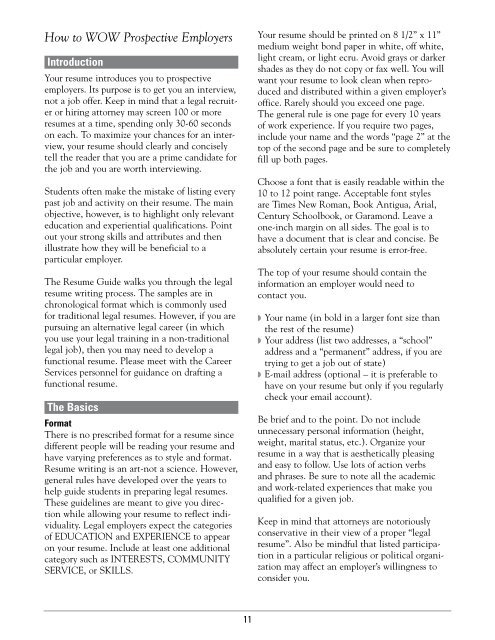UDSL Job Search Manual - University of Dayton
UDSL Job Search Manual - University of Dayton
UDSL Job Search Manual - University of Dayton
Create successful ePaper yourself
Turn your PDF publications into a flip-book with our unique Google optimized e-Paper software.
How to WOW Prospective Employers<br />
Introduction<br />
Your resume introduces you to prospective<br />
employers. Its purpose is to get you an interview,<br />
not a job <strong>of</strong>fer. Keep in mind that a legal recruiter<br />
or hiring attorney may screen 100 or more<br />
resumes at a time, spending only 30-60 seconds<br />
on each. To maximize your chances for an interview,<br />
your resume should clearly and concisely<br />
tell the reader that you are a prime candidate for<br />
the job and you are worth interviewing.<br />
Students <strong>of</strong>ten make the mistake <strong>of</strong> listing every<br />
past job and activity on their resume. The main<br />
objective, however, is to highlight only relevant<br />
education and experiential qualifications. Point<br />
out your strong skills and attributes and then<br />
illustrate how they will be beneficial to a<br />
particular employer.<br />
The Resume Guide walks you through the legal<br />
resume writing process. The samples are in<br />
chronological format which is commonly used<br />
for traditional legal resumes. However, if you are<br />
pursuing an alternative legal career (in which<br />
you use your legal training in a non-traditional<br />
legal job), then you may need to develop a<br />
functional resume. Please meet with the Career<br />
Services personnel for guidance on drafting a<br />
functional resume.<br />
The Basics<br />
Format<br />
There is no prescribed format for a resume since<br />
different people will be reading your resume and<br />
have varying preferences as to style and format.<br />
Resume writing is an art-not a science. However,<br />
general rules have developed over the years to<br />
help guide students in preparing legal resumes.<br />
These guidelines are meant to give you direction<br />
while allowing your resume to reflect individuality.<br />
Legal employers expect the categories<br />
<strong>of</strong> EDUCATION and EXPERIENCE to appear<br />
on your resume. Include at least one additional<br />
category such as INTERESTS, COMMUNITY<br />
SERVICE, or SKILLS.<br />
Your resume should be printed on 8 1/2” x 11”<br />
medium weight bond paper in white, <strong>of</strong>f white,<br />
light cream, or light ecru. Avoid grays or darker<br />
shades as they do not copy or fax well. You will<br />
want your resume to look clean when reproduced<br />
and distributed within a given employer’s<br />
<strong>of</strong>fice. Rarely should you exceed one page.<br />
The general rule is one page for every 10 years<br />
<strong>of</strong> work experience. If you require two pages,<br />
include your name and the words “page 2” at the<br />
top <strong>of</strong> the second page and be sure to completely<br />
fill up both pages.<br />
Choose a font that is easily readable within the<br />
10 to 12 point range. Acceptable font styles<br />
are Times New Roman, Book Antigua, Arial,<br />
Century Schoolbook, or Garamond. Leave a<br />
one-inch margin on all sides. The goal is to<br />
have a document that is clear and concise. Be<br />
absolutely certain your resume is error-free.<br />
The top <strong>of</strong> your resume should contain the<br />
information an employer would need to<br />
contact you.<br />
◗ Your name (in bold in a larger font size than<br />
the rest <strong>of</strong> the resume)<br />
◗ Your address (list two addresses, a “school”<br />
address and a “permanent” address, if you are<br />
trying to get a job out <strong>of</strong> state)<br />
◗ E-mail address (optional – it is preferable to<br />
have on your resume but only if you regularly<br />
check your email account).<br />
Be brief and to the point. Do not include<br />
unnecessary personal information (height,<br />
weight, marital status, etc.). Organize your<br />
resume in a way that is aesthetically pleasing<br />
and easy to follow. Use lots <strong>of</strong> action verbs<br />
and phrases. Be sure to note all the academic<br />
and work-related experiences that make you<br />
qualified for a given job.<br />
Keep in mind that attorneys are notoriously<br />
conservative in their view <strong>of</strong> a proper “legal<br />
resume”. Also be mindful that listed participation<br />
in a particular religious or political organization<br />
may affect an employer’s willingness to<br />
consider you.<br />
11

















